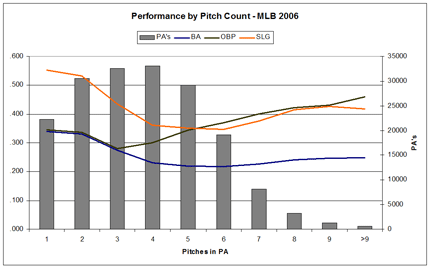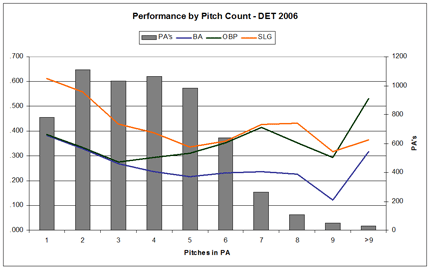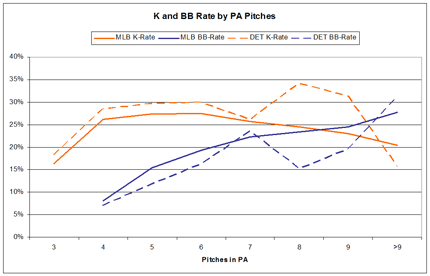Certainly there is more to plate discipline than first pitch swinging. We’ve seen that the Tigers aggressiveness in that regard actually pays dividends. We also know that the Tigers strike out more than any other team in the American League and walk less than only the Cubs and Mariners. One hazard of first pitch swinging is that it short circuits long at-bats, but is there a benefit to working deep into the count?
Once again through the magic of Retrosheet we can delve into the data from 2006. The following two charts reflect batting performance based on the length of the plate appearance (I removed intentional walks altogether from the following). The first chart is for MLB in its entirety. The second is just for Detroit.


The first thing to notice on both charts is the dramatic shift in favor of the pitcher in 3 pitch PA’s. Part of this might be the ability for a batter to fan and not walk, but the isolated power also takes a hit here. Batting average and slugging percentage dip as the swings get more defensive late in the count. In terms of the Tigers, the biggest thing to notice is that when an at-bats get longer for the rest of baseball, say more than 6 pitches, OBPs exceed .400. However that isn’t the case for Detroit.
It seems that while the Tigers are aggressive on good pitches early in the count (as evidenced by their success), their aggression late in the account certainly hurts their ability to draw walks. They do generally maintain a slugging advantage, but that advantage is entirely negated by the hit they take late in the count getting on base.
Not surprisingly, a look at the walk and strike out rates by at-bat length compared to the rest of the league shows the Tigers to be at a disadvantage as well.

Lynn Henning had an interesting article indicating that the Tigers were focusing on cutting down on strike outs. Though the data shows that even with the strike outs, the Tigers can hold their own in terms of hitting and slugging. Of course situations call for different circumstances and new hitting coach Lloyd McClendon seems to have a feel for this.
“It also depends on the situation. If there are two outs, nobody on and you’re down a run, and a guy who’s hitting 30 home runs is up, I don’t think you need to have him protecting the plate in a two-strike situation. You want him to hit the ball out of ballpark. But in the eighth inning with a runner at third and you’re trying to tie the game, it’s going to be important to put the ball in play.”
As for the distribution of plate appearances, the Tigers are in line with the league for longer PA’s matching the mark for PA’s greater than 4 pitches (~34%). The Tigers have more 1 and 2 pitch at-bats of which they have success in exchange for fewer 3 pitch at-bats in which hitters don’t fare so well.
MLB DET ==== ==== Pit % of PA's Cum % % of PA's Cum % --- -------- ----- --------- ----- 1 12% 12% 13% 13% 2 17% 29% 18% 31% 3 18% 47% 17% 48% 4 18% 66% 18% 66% 5 16% 82% 16% 82% 6 11% 93% 11% 93% 7 5% 97% 4% 97% 8 2% 99% 2% 99% 9 1% 100% 1% 99% >9 0% 100% 1% 100%
The biggest difference comes down to walks. Some of it may be aggressiveness and some is probably recognition. Strikeouts aren’t the problem, and short ABs aren’t the problem. As rudimentary as it seems the Tigers just need to get better at taking a walk when the opportunity presents itself.
The information used here was obtained free of charge from and is copyrighted by Retrosheet. Interested parties may contact Retrosheet at www.retrosheet.org.
Great job, Billfer. There’s only one question left: To what degree did they follow the advice in Lloyd’s quote?
Wow – those are Great stats. Of course my first reaction is baseball fans don’t get out much, but my second reaction was this really pinpoints something that we have seen. You look at Pudge for example. He would make one or two bad swings early and it is like he gives up the at bat by trying to do too much with the later pitches. Almost like he is over thinking it.
Jeff – that’s something I can check, sort of. Give me a couple days.
The problem with using pitch count as the independent variable is that certain situations are mutually exclusive.
For example, a one or two pitch count plate appearance means the ball was hit into play. A player can not reach base on a walk without a plate appearance with at least 4 pitches.
The variety of situations inherent in each pitch count variable makes some of this analysis less meaningful. For example, a 10 pitch plate appearance could be 6 straight 2-2 count pitches, a 3-1 count followed by 5 straight strikes/fouls, or many different situations.
Mark – I fully understand some of the issues and I wasn’t necessarily trying to come up with new theories or meanings. It was simply a look back at what happened. It was born out of one of the big complaints about the Tigers offense is that they couldn’t work deep in the count.
If I was going to try and extract anything from this, it may be that the theory of waiting out a pitcher until he makes a mistake is probably hampered by the fact that because players are swinging more defensively later in the count with 2 strikes they aren’t really crushing those mistakes.